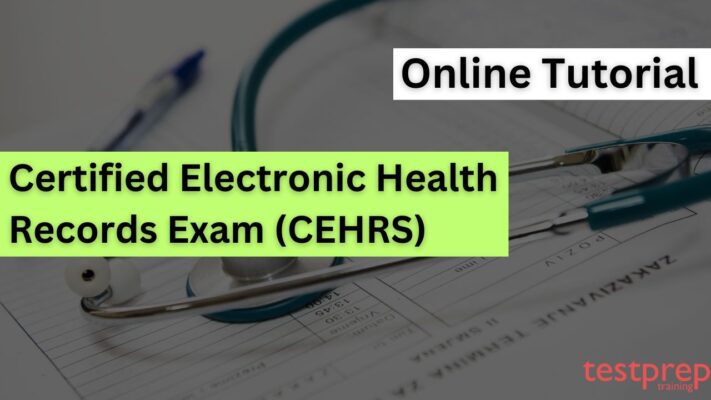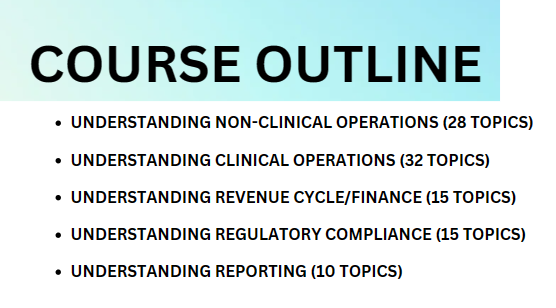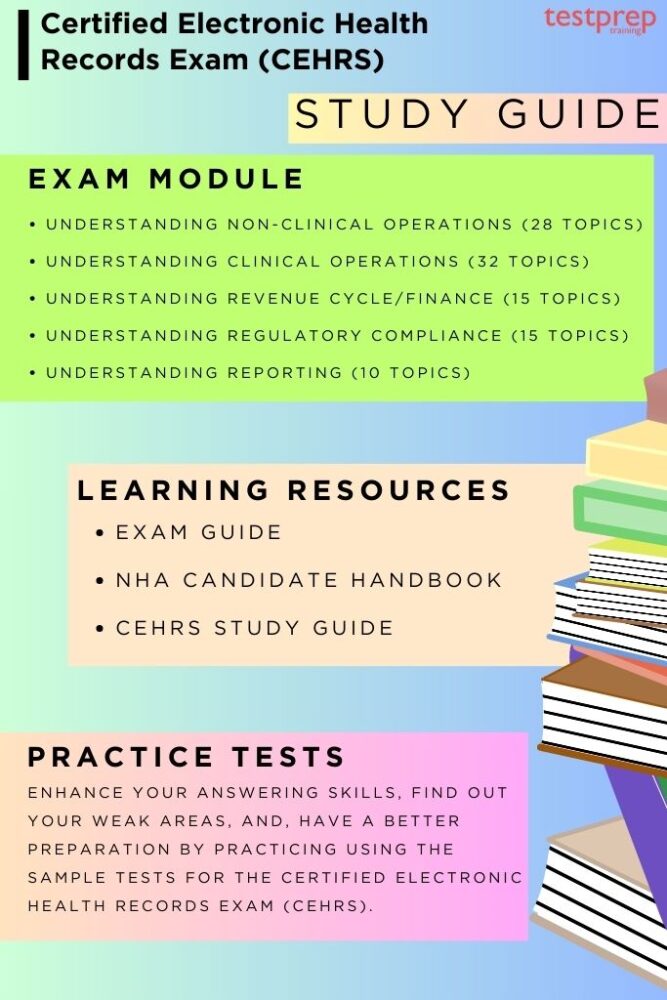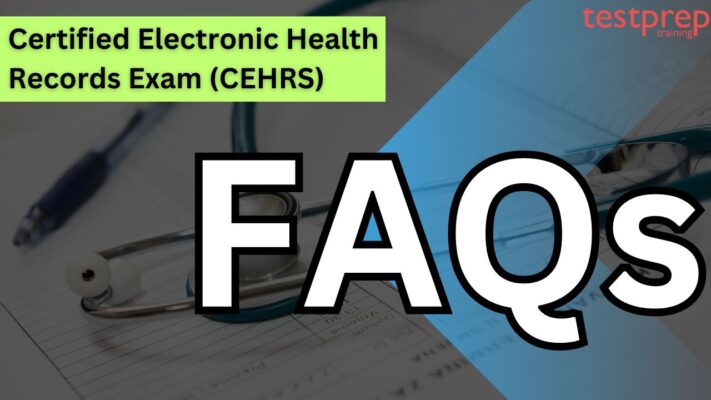Certified Electronic Health Records Exam (CEHRS)

Ensuring the security, thoroughness, and correctness of patient information is crucial. Many times, professionals pair the Electronic Health Records Specialist Certification (CEHRS) with other NHA credentials to broaden their skill set, making them more valuable to their employers. Some typical tasks associated with electronic health records involve:
- Checking patient records for compliance
- Extracting clinical details for reports
- Conducting basic coding to file reimbursement claims
- Handling Release of Information (ROI) requests for medical records
- Reviewing patient details like demographics and insurance information
- Communicating patient information with physicians and insurance professionals
Eligibility Criteria:
- Hold a high school diploma or GED/high school equivalency.
- Completed training or education as an electronic health records specialist in the last 5 years.
OR
- Hold a high school diploma or GED/high school equivalency.
- Have 1 year of supervised work experience in the electronic health records specialist field within the last 3 years; or 2 years of supervised work experience in the electronic health records specialist field within the last 5 years.
Exam Details

All NHA exams are in a multiple-choice format and are taken under supervised conditions. You can take the exams on a computer at most authorized places or testing centers. For locations that don’t support computer-based testing, paper/pencil exams are available if approved by NHA.
Each exam has a set number of questions and a time limit for completion. The questions include both scored ones and a few pretest questions. Pretest questions help decide if they should be included in future scored exams. You won’t know which ones are which, but only the scored questions count toward your final score.
Computer-based exams are scored using web-based testing software. Paper/pencil exams have their answer sheets scanned, and software scores them electronically. If you pass, you’ll get an email telling you how to print your certificate by logging into your NHA account.
If you want to retake the exam, log in to the NHA website, schedule the exam, and pay the fee. If you don’t pass on the first try, you can retake the exam after a 30-day waiting period. You have three attempts, with at least 30 days between each. If you don’t pass after the third try, you must wait a year before attempting it again. Each retake requires re-registering and paying the full exam price.
How to apply for the exam?
Here’s a step-by-step guide to applying for your exam:
Step 1: Log in to your Candidate account at NHANOW.com.
Step 2: Click on Apply on the left side of your page under Applications.
Step 3: Under Choose an exam, pick the certification type, and confirm you are registering individually.
Step 4: Read and agree to the Attestation at the bottom of the page.
Step 5: Answer the prerequisite question and choose to Register for Another Exam or Checkout.
Step 6: On the Checkout page, confirm your Basic/Billing information and click the tab at the bottom.
Step 7: Provide your payment type as needed and click Purchase Items, then return to the account dashboard.
Step 8: Click on Apply on the left side under Applications, and then Schedule with PSI.
Course Outline
Below are the exam topics that can help you prepare better for the exam:

Domain 1: Overview of Non-Clinical Operations (28)
- Learn to Verify patient identifiers before documenting in the EHR to ensure information is recorded in the correct chart.
- Learn to Collect, record, and continuously update patient information
- Learn to Generate encounter documentation
- Learn to Retrieve patient information from internal databases to integrate into a patient’s EHR.
- Learn to Acquire patient data from external sources
- Learn to Import information into the EHR from integrated devices
- Learn to Maintain inventory of EHR-related hardware
- Learn to Coordinate patient flow within the facility
- Learn to Provide initial and ongoing end-user training of EHR software to maintain competency
- Learn to Share information about updates to EHR software and the implications for workflow.
- Learn to Identify data discrepancies within and among multiple EHRs, practice management systems, and other software systems.
- Learn to Report or reconcile data discrepancies within and among multiple EHRs, practice management systems, and other software systems.
- Learn to Provide support to patients regarding their use of patient portals
Domain 2: Overview of Clinical Operations (32)
- Learn to Develop clinical templates for data capture
- Learn to Securely transmit and exchange patient data internally and externally for research, analytics, and continuity of care.
- Learn to Review and monitor clinical documentation to ensure completeness and accuracy
- Learn to Provide point-of-care EHR support for clinical documentation.
- Learn to Input real-time clinical data into the EHR.
- Learn to Document patient historic clinical data in the EHR
- Learn to Provide support for computerized provider order entry (CPOE).
- Learn to Locate and provide patient education materials available within the EHR.
- Learn to Navigate the EHR system to retrieve requested patient data.
Domain 3: Overview of Revenue Cycle/Finance (15)
- Learn to Find codes in databases
- Learn to Navigate the EHR to create a superbill, encounter forms, fee slips, or charge forms.
- Learn to Enter the diagnosis and procedure codes billing information into the EHR system for claims processing.
- Learn to Verify that all diagnoses and procedural descriptions for reimbursement are accurately documented in the EHR.
- Learn to Verify insurance and eligibility in the EHR.
- Learn to Obtain and document authorizations in the EHR.
- Learn to Provide estimated patient costs.
- Learn to Navigate the EHR to provide patient statements.
- Learn to Collect and post payments to a patient’s account.
Domain 4: Regulatory Compliance (15)
- Learn to Adhere to professional standards of care as they pertain to health records.
- Learn to Maintain confidentiality and security of protected health information (PHI) in compliance with the HIPAA Privacy Rule, the Health Information Technology for Economic and Clinical Health (HITECH) Act, and facility policy.
- Learn to Educate others regarding compliance with best practices to safeguard electronic information and assist with enforcement of compliant behaviors.
- Learn to Identify non-compliant behaviors (e.g., sharing passwords, unlocked room) that represent threats to the security of electronic information.
- Learn to Allocate access controls within the EHR system based on user roles and predetermined privileges.
- Learn to Verify and assist with compliance of access controls (i.e., privileges) within the EHR system.
- Learn to De-identify protected health information (PHI).
- Release protected health information (PHI) in accordance with the HIPAA Privacy Rule and facility policy.
- Learn to Participate in internal audits of the EHR (e.g., consent forms, release of information forms, signature on file).
- Learn to Comply with regulations regarding the use of abbreviations in the EHR system.
- Learn to Initiate down-time procedures related to the EHR (e.g., data recovery).
- Learn to Comply with the requirements of EHR incentive programs.
Domain 5: Reporting (10)
- Learn to Run and execute standardized financial reports
- Learn to Run and execute standardized clinical reports to track patient outcomes for the support of continuity of care.
- Learn to Generate ad hoc financial reports using fields in the EHR system.
- Learn to Generate ad hoc clinical reports using fields in the EHR system.
- Learn to Generate statistical reports for quality improvement (QI) measures, productivity, metrics, and research.
- Learn to Compile data from the EHR for external reporting
- Learn to Verify the accuracy of generated reports prior to distribution
Certified Electronic Health Records Exam (CEHRS) Exam FAQs
Certified Electronic Health Records Exam (CEHRS) Study Guide

1. Understand Exam Guide
Understanding the exam guide is crucial for effective exam preparation. The guide serves as a roadmap, outlining the format, content, and expectations of the exam. It provides valuable insights into the types of questions you’ll encounter, the time constraints, and any specific rules or instructions. By thoroughly reviewing the exam guide, you can tailor your study plan to focus on key areas, ensuring that you cover the necessary topics.
Additionally, understanding the guide helps alleviate test-day anxiety, as you’ll be familiar with the structure and requirements. It’s a valuable resource to enhance your overall readiness and increase your confidence when approaching the actual exam. Take the time to carefully go through the exam guide, making it an integral part of your preparation strategy for a successful exam experience.
2. Use the NHA Candidate Handbook
The Candidate Handbook contains details about the National Healthcareer Association (NHA), including the certification exams and credentials available across different allied healthcare sectors.
NHA provides certification exams for allied health professionals, covering eligibility, application, exam processes, and result reporting. The guidelines in this handbook also include rules of conduct and potential disciplinary actions. Completing an NHA certification exam signifies that you possess the necessary knowledge and skills for entry-level practice in the respective field. Once you pass the exam, you receive credentials confirming your certified status.
3. Use CEHRS Study Guide
The Study Guide is accessible in two ways: interactively online or as a physical book sent to the student. The guide’s content aligns with NHA test plans, and the online version offers additional features such as practice drills, audio narration, and videos, making the learning experience more engaging.
4. Take Practice tests
The practice test is crafted to match the real certification exam, providing an online evaluation for students to assess their potential performance and pinpoint areas for improvement. Students have the flexibility to take the practice test up to five times, and they also get access to Focused Review, a robust tool offering personalized study recommendations based on their practice test results.



